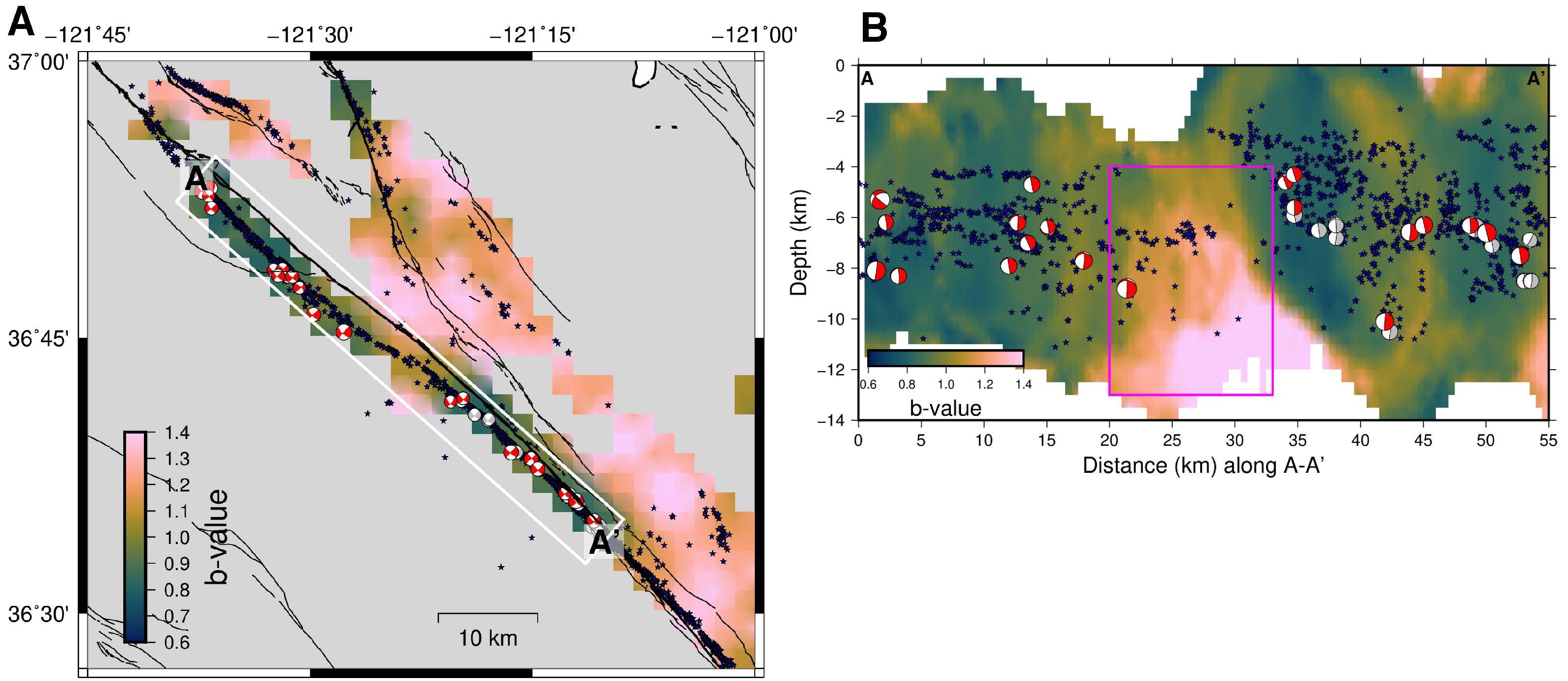
 |
|
 i
i
Spatial variations of b-values from 1993-2021 with repeating earthquakes (blue stars) and focal mechanisms of moderate-sized local earthquakes. A) Map of b-values computed in 2 km^2 grid spacing with ~50% overlap with a minimum of 50 events above the magnitude of completeness. The study area is indicated by the white rectangle. B) b-values in cross-section A-A’ computed with R=4 km (width +/- 3 km) and 0.5 km grid spacing. Magenta box indicates high b-value patch.
| Project Summary |
The central creeping section of the San Andreas fault (SAF) from Parkfield in the south to San Juan Bautista (SJB) in the north is creeping aseismically and separates the locked portions of the fault that rupture in great earthquakes. The transition between creeping and locked fault sections is a preferential zone of earthquake nucleation, where frictional heterogeneity leads to a complicated relationship of seismic and aseismic slip. The location in a locking transition, numerous moderate-sized local earthquakes, a historic record of aseismic slip transients, and dense instrumentation near SJB make it an excellent natural laboratory to study the interplay of seismic and aseismic slip. We are combining seismic and geodetic observations from 1993-2021 to study aseismic slip transients and their relationship to moderate-sized local earthquakes and address a number of fundamental questions: How often does aseismic slip lead to earthquakes, how often do these earthquakes lead to aseismic slip? What is the relationship between shallow and deep slip? What are the scales and patterns of spatiotemporal changes in creep rate along this locking transition? What is the largest earthquake we can expect in the region? We are searching for near-repeating and repeating earthquakes related to 20 moderate-sized local earthquakes that may be indicative of triggered aseismic slip transients. We further look at detailed spatial changes in earthquake statistics and an anomalous region potentially indicative of increased locking. We are also exploring spatiotemporal changes in frequency content of earthquakes that may illuminate variable frictional fault properties. We will combine these seismic observations with geodetic (i.e., cGPS, InSAR, creepmeters, borehole strainmeters) data to confirm apparent changes in creep rates and model aseismic slip transients. Further, we are installing new creepmeter pairs to capture propagation velocity of creep events along the SAF to better evaluate changes in creep rates along the fault. Studying the interplay of seismic and aseismic slip in this well-instrumented region may provide insights into other tectonic environments, particularly the offshore portion of subduction zones, where direct observations are limited.
|
| Tools | Repeating earthquakes, creepmeters, InSAR, GPS |
| Geographic Location | San Juan Bautista, central California |
| Group Members Involved |
Heather Shaddox <Email> <Personal Web Site> Roland Bürgmann, Roger Bilham |
| Project Duration | 2021-2023 |
| More Information | |
|
|